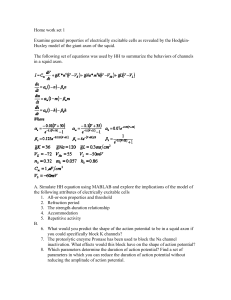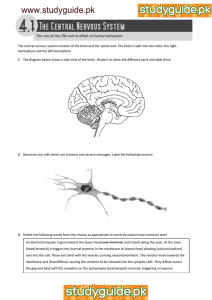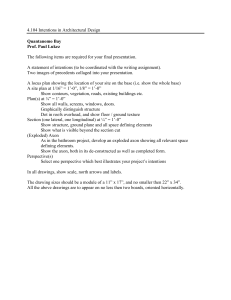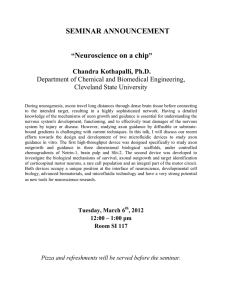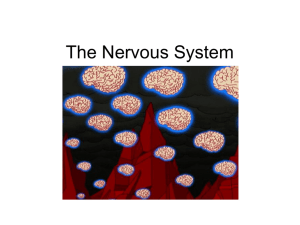Nerve structure, axons, dendrites. Axons ~ 5μm in radius, Schwann
advertisement
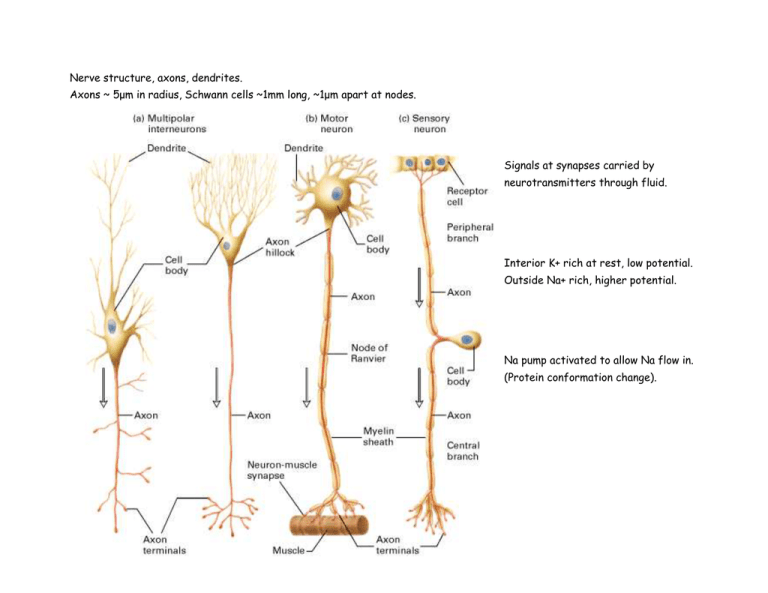
Nerve structure, axons, dendrites. Axons ~ 5μm in radius, Schwann cells ~1mm long, ~1μm apart at nodes. Signals at synapses carried by neurotransmitters through fluid. Interior K+ rich at rest, low potential. Outside Na+ rich, higher potential. Na pump activated to allow Na flow in. (Protein conformation change). Activation pulse travels along axon in a wave. Myelin allows pulse to skip 1mm to next node, speeding up signal. Due to the inequality in the amounts of Na+ and K+ ions, there is a charge difference across the cell membrane and that means we have a capacitor! When the nerve fires and Na+ flows in, ions must later flow to re-establish the resting state. A flow of charge along with the potential difference across the membrane means that Ohm’s law allows us to associate a resistance with the nerve. Electric Potential and ion concentration: From the Boltzmann distribution of particles among different energy levels at a given temperature, we have the concentration ratios for inside and outside the cell as ci co e q (Vi Vo ) kT or q(Vo Vi ) kT ln ci co This is another version of the Nernst equation used in Chemistry. This is the source of the potential difference across the axon membrane due to ion concentration differences. An axon in the resting state is much higher in potassium ion concentration than the fluid outside the cell and much lower in both chloride and sodium ions. The additional negative ions inside the axon are amino acid ions. Typical values for Axons: Quantity Axoplasm resistivity , ρa Capacitance/Area of membrane, Cm Resistance of unit Area of membrane, Rm Myelinated 2 Ω·m 5E-5 F/m2 40 Ω·m2 Unmyelinated 2 Ω·m 1E-2 F/m2 0.2 Ω·m2 Resistance for ion flow in axoplasm: R = ρaℓ/A = (2 Ω·m) ℓ/π(5x10-6m)2 = 2.6 x 108 Ω/cm = R for 70,000 km of #40 Cu wire! Or R for 2.7km of Si with cross section of 0.25cm2. As the charges flow inside the axon, we have a new situation: Charge flows along the circuit path (axon), but it may also leak out the sides (which was not possible with our wires in the last unit). There is a certain length at which the electrical resistance along the axon (the axoplasm resistance) is equal to the leakage resistance through the walls. [1] The resistance to flow through the axoplasm is calculated above. Determine the leakage resistance per cm for the unmyelinated axon and the myelinated axon using Rm from the table and the area per length ℓ is A=2πrℓ. [2] Find the length ℓ at which Rleak = Rplasma for both myelinated and unmyelinated axons. This is the length at which more signal is lost to leakage than flows down the axon. After the characteristic length ℓ calculated above, the signal must be amplified, which costs energy. Capacitance [3] Calculate the values for the capacitance C = Cm 2π r ℓ 1 cm of myelinated axon : of and 1 cm of unmyelinated axon : [4] Thinking about how the capacitance of a parallel plate capacitor is related to its structure, why is the capacitance per length of myelinated nerve lower than that for the unmyelinated one? Timing We have capacitance and resistance values for the axon wall, let’s see what we get for an RC time constant for discharging or recharging the capacitor charge layers along the membrane. [5] Using the Rm and Cm values in the table, determine the RC time constant for changing the potential across the nerve membrane. Is the value different for myelinated and unmyelinated nerves? Repeat with the Ra value calculated at the beginning instead of the Rleak value. If you compare this with the timescale of the axon potential curve, you see it is the right ballpark, but still slow by a bit less than an order of magnitude. This is because leakage through the membrane is only one way charge is transferred. The ion channels allowing active transport when opened play a huge role here in transferring ions more quickly across the membrane. This is, however, useful for analyzing the signal speed along an axon. This speed is equal to X/T where X is the distance between signal refresh (between nodes of Ranvier) and T is the RC time constant (to within a factor of 3 or so). The appropriate resistance to use here is the internal resistance Ra, since almost all of the charge flow is along the axon in the myelinated section between the nodes of Ranvier. The nodes are on the order of 1mm apart in a myelinated cell and using RC = RaC should be as good as the data, because there are no ion channels between the nodes. [6] Calculate the signal velocity = 1mm/RC for the myelinated axon. [7] Values for the squid giant axon (1mm diameter, unmyelinated) have been reported to be around 25 m/s, how does your number compare and why? Think of how the radius of the axon affects the calculation, the radius of the squid giant axon is about 1mm. To go further and refine the model, we need to put in more detail and make the components of our model correspond more closely to the physiology of the nerve. We will explore one step further in constructing a circuit model of the axon between sodium pores. Modeling the axon as a circuit The axon can be modeled as an RC circuit with the conduction (Ra) and leakage (Rw) resistances and the capacitance of the membrane. The following diagram gives a simplistic treatment of the axon circuit: Consider only the first stage, prior to the second Ra. [7] If there were no current to the capacitor, what would the voltage across the capacitor be in terms of V, R a and Rw? [Hint: use Ohm’s Law V = IR and take the potential at the lower horizontal trace to be zero.] [8] Is the capacitor charged or discharged when the current stops flowing to it? Applying Kirchoff’s laws to the first stage of the circuit gives the following 3 equations: V- I1R1 - Vc = 0 Vc – I2R2 = 0 From the third equation we get I1 = I2 + Ic Ic = I1 – I2 Solving the first 2 equations for I1 and I2 and substituting the expressions in the previous equation gives (V Vc) R1 Vc R2 Ic V 1 Vc R1 R1 1 R2 Ic The first term is a constant, the second term involves the changing value V c. The term in brackets is 1/Rll where Rll is the resistance of R1 and R2 in parallel. Multiplying by Rll and writing Ic as ΔQ/Δt = C ΔVc/Δt gives V R R1 Vc RC Vc t Since the RC value in front of ΔVc/Δt is RllC, this is the time constant for the circuit. The first term gives the maximum value for Vc. [9] Write an expression for the potential across the capacitor as a function of time, starting at Vc = 0. [10] Extending this treatment, write a similar expression for the second capacitor in line. How about for the nth capacitor? Such behavior agrees semi-quantitatively with data measured on actual neurons. This drop in potential over distance requires amplification of the signal, which is accomplished by triggering the sodium channels to open and replenish the potential strength. Below is a trace of a pulse in the squid axon and some of the characteristics of the axon and signal. Giant Squid Axon, ~ 1mm diameter, unmyelinated. V(signal) ~25m/s (Wik) More discussion can be found on the hyperphysics site: http://hyperphysics.phy-astr.gsu.edu/Hbase/biology/actpot.html Video of original work on Giant Squid Axon: http://www.science.smith.edu/departments/NeuroSci/courses/bio330/squid/squid4% 20.html
